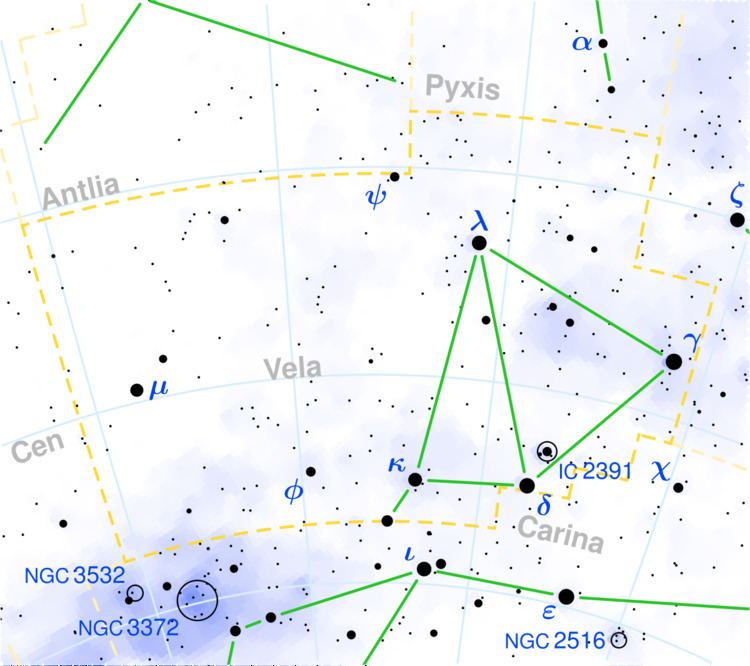Luminosity (bolometric) 170,000 L☉ Primary O Semi-amplitude (K2)(secondary) 122 ± 2 km/s | Luminosity (bolometric) 280,000 L☉ Companion WR | |
 | ||
Gamma Velorum (γ Vel, γ Velorum) is a multiple star system in the constellation Vela. At magnitude +1.7, it is one of the brightest stars in the night sky, and by far the closest and brightest Wolf-Rayet star. It has the traditional name Suhail al Muhlif and the modern name Regor, but neither is approved by the International Astronomical Union.
Contents
Distance
Gamma Velorum is close enough to have accurate parallax measurements as well as distance estimates by more indirect means. The Hipparcos parallax for γ2 implies a distance of 342 pc. A dynamical parallax derived from calculations of the orbital parameters gives a value of 336 pc, similar to spectrophotometric derivations. A VLTI interferometry measurement of the distance gives a slightly larger value of 368+38
−13 pc. All these distances are somewhat less than the commonly assumed distance of 450 pc for the Vela OB2 association which is the closest grouping of young massive stars.
Components
The Gamma Velorum system is composed of at least four stars. The brightest member, γ² Velorum or γ Velorum A, is a spectroscopic binary composed of a blue supergiant of spectral class O7.5 (~30 M☉), and a massive Wolf-Rayet star (~9 M☉, originally ~35 M☉). The binary has an orbital period of 78.5 days and separation varying from 0.8 to 1.6 astronomical units. The Wolf-Rayet star is likely to end its life in a Type Ib supernova explosion; it is one of the nearest supernova candidates to the Sun. The Wolf Rayet star has traditionally been regarded as the primary since its emission lines dominate the spectrum, but the O star is visually brighter and also more luminous. For clarity, the components are now often referred to as WR and O.
The bright (apparent magnitude +4.2) γ¹ Velorum or γ Velorum B, is a spectroscopic binary with a period of 1.48 days. Only the primary is detected and it is a blue-white giant. It is separated from the Wolf-Rayet binary by 41.2", easily resolved with binoculars. The pair are too close to be separated without optical assistance, and they appear to the naked eye as a single star of apparent magnitude 1.72 (at the average brightness of γ2 of 1.83).
Gamma Velorum has several fainter companions that share a common motion and are likely to be members of the Vela OB2 association. The magnitude +7.3 CD-46 3848 is a white F0 star at is 62.3 arcseconds from the A component. At 93.5 arcseconds is another binary star, an F0 star of magnitude +9.2.
γ Velorum is associated with several hundred pre main sequence stars within less than a degree. The ages of these stars would be at least 5 million years.
Etymology
The Arabic name is al Suhail al Muḥlīf. al Muhlif refers to the oath-taker, and al Suhail is originally derived from a word meaning the plain. Suhail is used for at least three other stars: Canopus; λ Velorum (al Suhail al Wazn); and ζ Puppis (Suhail Hadar). Suhail is also a common Arabic male first name.
The Chinese name for the star is 天社一 (Mandarin: tiān shè yī), which means "The First Star of the Celestial Earth God's Temple."
The name Regor ("Roger" spelled in reverse) was invented as a practical joke by the Apollo 1 astronaut Gus Grissom for his fellow astronaut Roger Chaffee.
Due to the exotic nature of its spectrum (bright emission lines in lieu of dark absorption lines) it is also dubbed the Spectral Gem of Southern Skies.
